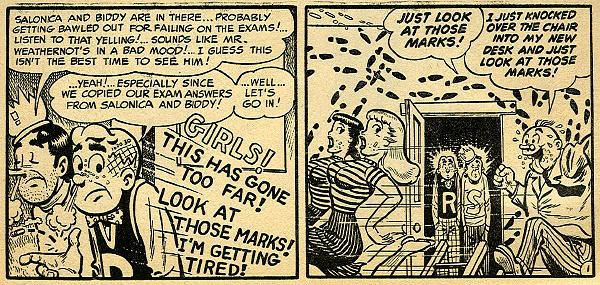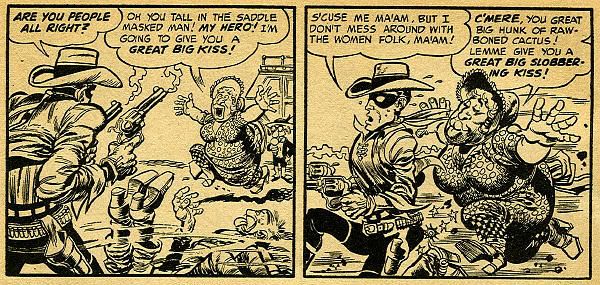
Number 189
How I went Mad in the 1950s
As a kid I never kicked and fussed when Mom took me to the grocery store, because it gave me a chance to stand near the magazine rack and paperback book spinner, ogling the sexy covers. On one occasion in 1955 or thereabouts I spotted a book I'd never seen before, The Mad Reader.
I opened it up to the first panel of Wally Wood's "Superduperman" story, and the rest, as they say, is history.
The problem is, as much as I wanted this book, and I wanted it really, really bad, Mom wouldn't buy it for me. Mom was aware of the talk about evil comic books turning children into juvenile delinquents, and while she let me read comic books she approved of (Uncle Scrooge, Little Lulu, etc.), she wasn't about to let me go over the line to something like Mad.
I went home disappointed, then my obsessive-compulsive disorder kicked in. When I wanted something as bad as I wanted this book I usually kept up a whining, obnoxious pleading until my parents caved in. Since Mom had said no, I went to my dad. Dad was usually more easygoing when it came to things like this. Listening to me bellow, snivel and whine for about an hour was all it took. He went to the store to find the book for me.
It's said that Mad, in its original comic book incarnation, was a flop saleswise until issue #4, which had the Wood "Superduperman" story. From that time on Mad became a cult favorite. Even my future brother-in-law, who was in in high school in the early '50s, bought Mad, as did his buddies. Mad was real gone! It was hep! I didn't know any of that, though. I just knew that I recognized who Superman was, I knew who the Lone Ranger was, I knew the comic book character, Archie, and I loved the grotesque, funny artwork of Wally Wood, Bill Elder and Jack Davis. They took all of those familiar characters and turned them inside out and upside down. They turned them into jokes. From that book I went on to the other Mad paperbacks, like Mad Strikes Back, Inside Mad, and Utterly Mad. From the time I first held these books I was hooked, a junkie to the drug of Mad-ness.
Mom's problem with Mad was the effect the drawings had on her, which was the exact opposite of the effect they had on me. She claimed they "made her head spin." They did that to me, too, just in a good way.
Take "Starchie, "Bill Elder's version of Archie. The art is very close to the original. The people who produce the Archie comics like to tout their comics as being wholesome, but there was no doubt that the whole subtext of their comic books was some sort of triangular sexual thing going on between Archie, Betty and Veronica. The author and editor of Mad, Harvey Kurtzman, always went for the most obvious satirical elements of what he was lampooning, and that is the crux of this story, behind its more obvious elements of Starchie and gang as juvenile delinquents.
The Lone Ranger was a guy who traveled around with a Native American companion and wore a mask. As in this Mad version called "The Lone Stranger," he steered clear of womenfolk. One might ask why? And did he and Tonto share body heat around the campfire? Anyway, when I saw this Jack Davis panel of the Lone Stranger being chased by the ugly "girl," I laughed my guts out. Yes, the lady chasing the Lone Stranger is actually a man in drag.
I was a big fan of Mad in the 1950s, but the two entities, the Mad paperback books and the regular Mad, magazines being published every couple of months, were entirely different things. I wondered why, but didn't know why they were different until later when I found out about the two editors, first Kurtzman, then Al Feldstein, about the Comics Code, about the color comic book after 23 issues becoming a 25¢ black and white periodical. Much to my mom's displeasure, despite a lot of yelling, burning my magazine collection, and even her outright theft of mail-ordered copies of early Mad comic books, I didn't give up on Mad.
What happened to me with The Mad Reader, I'm sure happened with a lot of people in my generation: aspiring cartoonists, comedians, actors, whoever. Who knew that such brilliance could exist in parody and satire? Looking back on that book today I still see the sort of genius I saw many years ago the first time I pulled it off the paperback rack.
*The copy of The Mad Reader at the top of this page is not my original Mad Reader, which was destroyed by my mother at some point in the late 1950s. This is a copy of a first printing I picked up in California 20 years ago.
0 nhận xét:
Đăng nhận xét